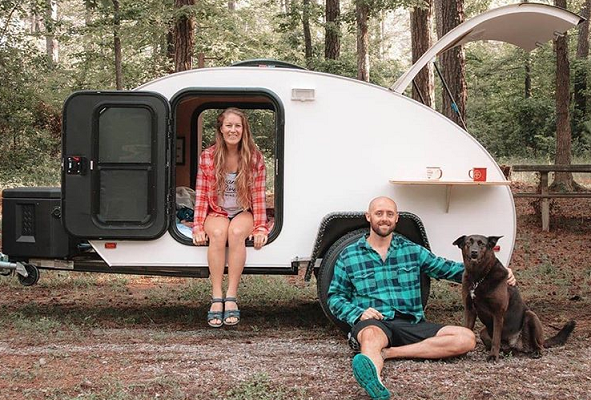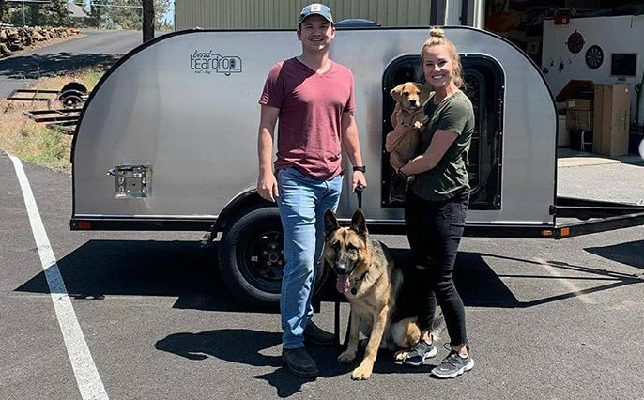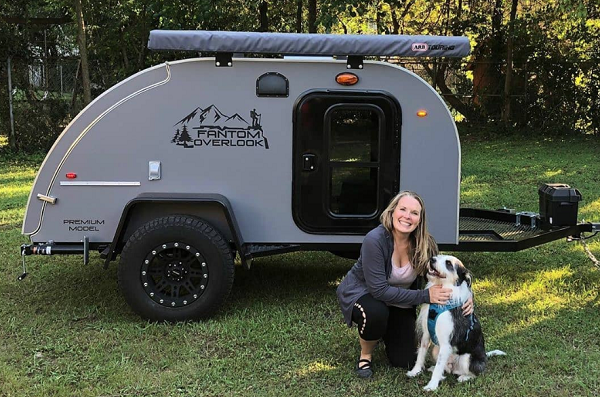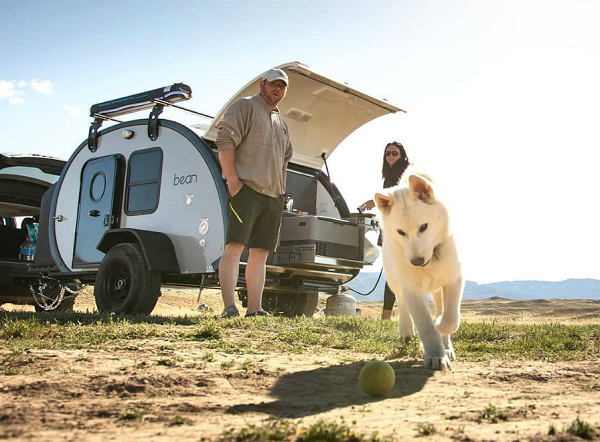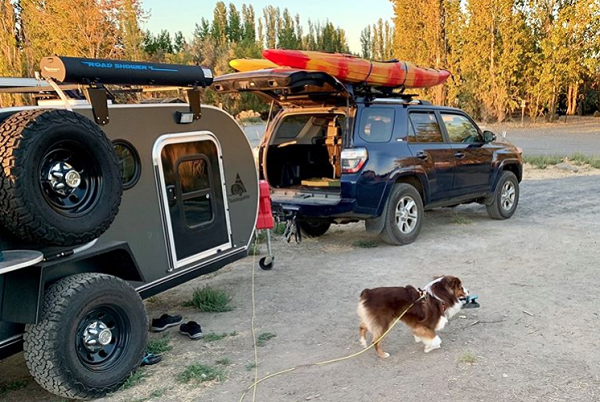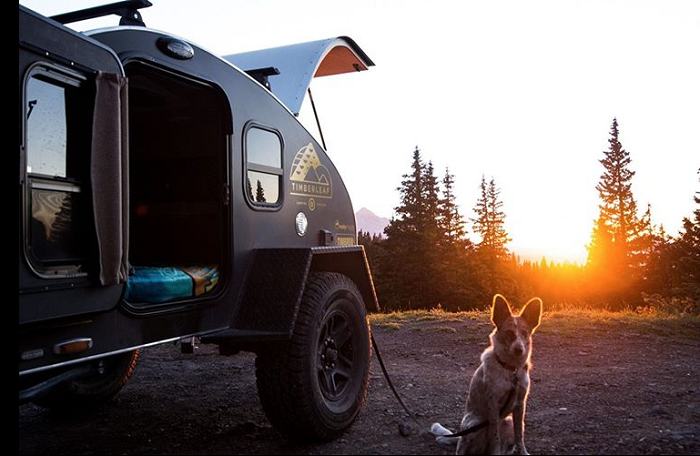Teardrop Camping with Dogs: The Complete Guide
Teardrop camping is a fun and unique experience where you experience the outdoors while having a cozy little camper to fall back on. It’s more economical than an RV but safer than a tent. But what if you want to bring your furry friend with you?
Teardrop camping with dogs is possible. However, there are many factors to consider, such as how obedient they are and if you have enough room, food, and water for them. You’ll also need to consider if the activities you will be doing can adequately include your dog.

In this article, we will be going over how you can successfully bring your dog with you on your next camping trip, how to make things go smoothly, and what circumstances would make it not ideal. If you’d like to learn more, we encourage you to read on.
What Is Teardrop Camping?
Many people are still planning what kind of camping trip they want to take, so we will briefly go over exactly what teardrop camping is.
A teardrop trailer is essentially a fun-sized version of a camper trailer, only consisting of a bed for two adults and a kitchen. They aren’t exactly cheap with a starting price of $5,000 that can quickly jump to $15,000 if you want nicer amenities. However, they are significantly cheaper than fully-featured small campers, which have an average cost of $20,000+.
Price aside, people prefer the teardrop experience because it makes them feel more connected to their surroundings and doesn’t take up more space than they need to. It’s a great way to go camping if you want something with a slice of home without making you feel like you are just staying in another house.
Now that we got that out of the way, how do you factor a dog into this? After all, there isn’t exactly an ample amount of space.
Should You Take Your Dog With You?
First things first, you need to consider if your dog is fit to go along with you. Your dog’s behavior will be everything in this case because many things can spook or distract them. Safety is of utmost importance for your dog, and so you consider these factors.
How Well Behaved Is Your Dog?
Dogs can have vastly different levels of obedience, depending on their temperament and how well they are trained. You need to consider if your dog can handle the trip by considering these points:
- How does your dog act in unfamiliar places? A dog can be incredibly sweet and obedient at home but become a handful once placed in a new environment. This isn’t all dogs, of course, but this is something to keep in mind.
- Does your dog obey you? Having a dog that is trained enough to listen to you is a must. Basic commands such as come, stay, don’t touch, and more are things all dogs should eventually learn. You’ll want to remain in control for the safety of your dog. If your dog is prone to running off, a camping trip might not be the best idea.
If you are outdoors with your dog quite often and they are fine and generally want to stick by your side, it’s safe to say they will make for an excellent companion on your trip.
Supplies
Bringing the right supplies on a camping trip is crucial, but what should you bring with a dog tagging along?
Supplies for a dog are fairly standard, and it is stuff you likely have thought about, such as food, water, and a leash, but there are other things to keep in mind.
Food
You can bring your dog’s normal food. We recommend giving them extra food for their meals since they will likely be burning more calories than usual on the trip. A foldable dog bowl such as this COMSUN Collapsible Dog Bowl can also be helpful for portability.
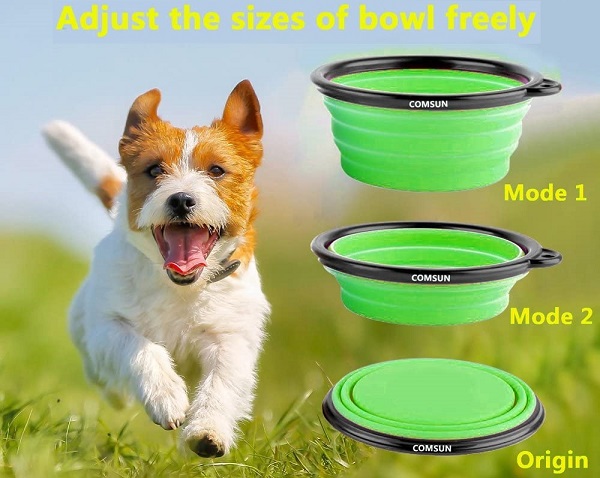
Additionally, consider what you will be eating. If you are cooking, your dog is probably going to want some of your tasty food. Hamburger is a great food to bring along on a camping trip in this case because it is great for both humans and dogs. However, you must ensure that your dog’s share doesn’t have added salt or seasonings.
If you aren’t cooking and instead of going the freeze-dried or pre-packaged food route, it is best to keep that for yourself due to all the added spices.
Water
Both you and your pup need to stay hydrated. For camping, it is recommended each human gets a gallon of water a day, and dogs get 1 ounce per pound every day. You can never bring too much water. Thus, we recommend taking along more than you think you’ll need just in case.
Always have water on hand for both you and are pooch when away from camp and look for signs when he is thirsty such as excessive panting.
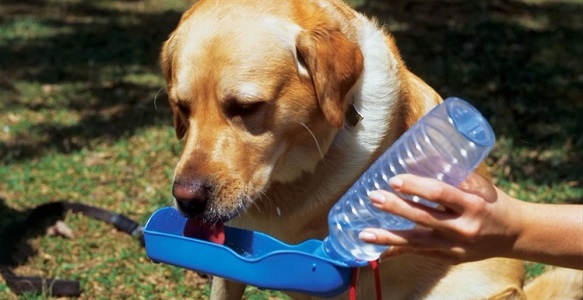
Leash
Even if your dog is at the point where you can casually walk them without a leash, it is still a very good idea to bring one and use it. With your dog out in nature, wildlife is part of the equation, and there is a real possibility that a wild animal could either spook them or go into pursuit mode. Then there’s the potential problem of other people’s dogs messing with your dog.
We are all about giving well-behaved dogs freedom and trust, but for special occasions like this, it is better to be safe and have your dog on a leash, especially if you are on camping grounds where campsites are relatively close together.
Waste Bags
Just like anywhere else, you’ll need to pick up after your dog. Even if they go into the woods off a trail path, picking up the waste is still the responsible thing to do because chances are, other people’s dogs have gone there. That mass build-up can contaminate the area, and it is best if all dog owners prevent this.
First-Aid Kit
You should have a first aid kit for both you and your dog. Your dog’s kit should include these items:
- Hydrogen peroxide
- Tweezers
- Bandages
- Tick and flea repellent
If you don’t already have an emergency kit for your pup, we recommend picking up the Dog First Aid Kit by PushOn. It hardly takes up any space and has the essentials you need. As one reviewer put it: “Buy it before you need it.”
ID Tags
If the worst happens and your dog gets lost. It is important to have an ID tag where others can contact you. It should include your name, phone number, campsite number, and campground location.
Blanket
A blanket will provide comfort for your dog while keeping them happy. In an unfamiliar area, having something they can claim as theirs will help. You can give them your blanket with your scent, which can help if they will sleep alone.
Toys
A mentally stimulated dog is a happy dog and when it is downtime, having their favorite toys to play can be comforting as it is something that reminds them of home. This can make the camping trip less stressful if your pup is prone to getting homesick. Since you will likely be bringing things to keep you entertained at camp, it is only fair and makes sense to provide your pooch with the same amenities.
Outerwear
Depending on where you are going, it might be a good idea to bring appropriate outerwear. If it is going to be hot outside, a water-soaked vest will keep your pup cool. On the flip side, if it will be chilly, then a dog coat will keep them warm.
Dog Shoes
On long walks over rough terrain can be hard on a dog’s paws, and the best way to circumvent discomfort is to have them wear dog shoes. QUMY Dog Boots are excellent for this purpose. It will take them a bit to get used to them.
Here’s a video showing how you can effectively train them to get used to wearing shoes:
Backpack for Dogs
This isn’t necessary, but keeping some of the dog’s supplies on them can lessen the load you have to carry. Something like this Onetigris Dog Pack is lightweight and comfortable. It can hold enough, but not too much to wear your dog down.
If you are the type that wants to pack as light as possible when hitting the trails, this can help out. We recommend allowing your dog to get used to wearing a pack before the day of your trip to ensure they feel comfortable wearing it.
The Sleeping Situation
Where the dog sleeps is not an easy answer. People who have taken their dog teardrop camping often come back, unsure how to solve this solution effectively. The main issue lies with the camper’s size typically being suitable for 2 humans, which becomes a real problem when trying to have a large dog in there. Of course, if it’s just you and your dog, there is plenty of space available.
There are a couple of choices you can make when deciding where your dog can sleep if the camper isn’t an option.
- Tent – Depending on how your dog copes with being alone, you can set up a tent specifically for them. Many dogs enjoy being in their den, potentially making this the perfect solution to sleeping woes. This Alcott Pup Tent is affordable and portable, but make sure it isn’t going to rain on your trip since it will not hold up against the water.
- Car – Some people opt to let their dog sleep in the car. Ensure that temperatures are not too hot or too cold for obvious reasons and lay down blankets to be comfortable. This solution is safer than a tent overall, and we don’t see a problem with it as long as it is a safe temperature outside, and they can handle being by themselves in the car.
Teardrop campers come in different sizes, stretching the definition of a teardrop and resembling a miniature camper complete with real sinks, a bathroom, and a queen-sized bed. It’s best to plan where your dog can sleep before departing accurately. There is a chance your pup will be able to sleep comfortably alongside you.
When Is It Best Not to Bring a Dog?
There are certain circumstances where bringing a dog camping is not a good idea. Remember, camping should be fun for anyone involved, human or dog, so it is important to consider these factors before deciding to have your canine friend tag along with you.
You Want to Walk All Day and Your Dog Doesn’t Have Much Stamina
A camping trip can be incompatible for dogs, depending on what you are doing. If you want to go sightseeing all-day, then it is probably best not to have them tag along. Even with dog boots, your pup doesn’t have the same plans and drive as you to see as many locations as possible and will likely tire out well before you do.
Of course, a fit dog can handle an outdoor adventure just fine and probably love it. We are just saying that an all-day exploring session may not agree with your dog.
Does your dog have the stamina for extended outdoor activities at all? Many dogs stay inside and lounge around with only the occasional walk, and going from that lifestyle to the great outdoors with constant physical activity is a huge jump. We recommend exercising your dog more if this sounds like your pup so he can enjoy physical activities right along with you.
Exercising your dog more also has other benefits such as it will help them stay fit, build more muscle, prevent the “zoomies” at inappropriate times, and reduce the risk of health problems later on.
In conclusion, it’s not fair to your dog to leave them at base camp or in the car if this is the current situation with your pup, they will be happier being with a good dog sitter, friend, or family member at home. You can plan more outdoor adventures in the future that are dog-friendly and exercise your dog more often to get them used to being on their feet for a longer period.
Your Dog Is Aggressive
It’s not uncommon for people to cut near another person’s campsite as a shortcut, which is a big problem with aggressive dogs. If your dog is prone to showing aggressive behavior towards strangers who get too close to where their territory is, nothing but problems will occur. This goes back into ensuring your dog is mentally equipped to handle camping.
Aggressive dogs are not only a problem when camping, but dog ownership in general. It’s hard to have guests over, and you’ll always run the risk of your dog getting loose, somehow attacking someone, whether that is an adult or child.
It’s not easy to change an aggressive dog’s temperament, but it should be done as soon as possible. A professional trainer can help in this case, and if you’d like to learn what you can do about it, here is a simple guide.
The Campsite Is Not Pet-Friendly
It is important to know as much as you can about the campsite before going there as rules can differ regarding pets. Some sites allow pets but don’t allow them on trails while other times, pets aren’t allowed.
In the line of previous statements, if you plan on hitting the trails often and don’t allow dogs, it is better if you don’t bring your furry friend as they are essentially missing out on the trip. See if there are any fully pet-friendly campsites near you. Chances are you have multiple options to choose from.
Your Dog Isn’t Trained
We previously talked about how a well-behaved dog is a must on a camping trip. They are in a new, unfamiliar environment with many things that could catch a dog’s attention. At the very least, they should come to you when called and stay in place when given the command.
A dog that is suited for camping is friendly, stays near you, and knows key commands. If you are still in the middle of training an adolescent dog, for example, you will run into problems bringing them into a camping environment.
Conclusion
Teardrop camping with a dog can be a fun, memorable experience that is great for bonding and letting your dog live life to his fullest. There are many things to consider before taking your pup, such as:
- Supplies
- Your dog’s behavior
- Your dog’s fitness
- If your activities are dog-compatible
- If your campsite is dog-compatible
If everything goes right, you can go on more camping trips with your dog. Just like when they see you reaching for the leash for a walk, they’ll get excited when they see you hitching your camper because they know that they will be in for a great time. We hope that this has helped answer your questions, and may your adventures bring you closer to your pup.
Sources
- General RV: A Complete Guide to Teardrop Trailers
- Natural pet Organics: How to Ease Your Dog’s Anxiety When Moving to a New Home
- Canidae: 7 Basic Commands Every Dog Should Know
- Halifax: Does Your Dog Have a Drinking Problem?
- Puppy Leaks: 10 Ways to Give Your Dog More Mental Stimulation
- Wag: How to Train Your Dog to Not Attack Strangers

